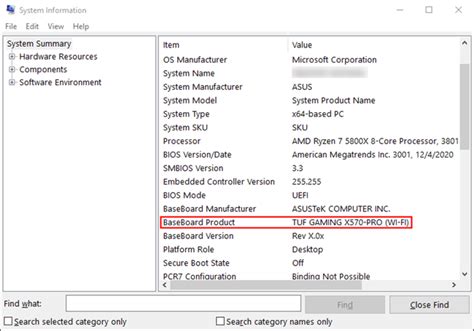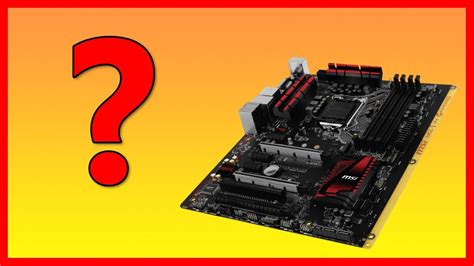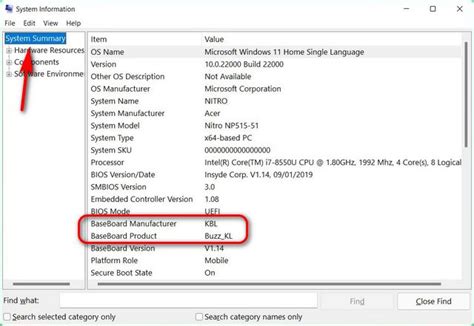Identifying the motherboard model in your computer is a crucial step for various purposes, including upgrading, troubleshooting, or ensuring compatibility with new components. The process can be straightforward and does not necessarily require technical expertise. In this article, we will explore the methods to check what motherboard you have, catering to different operating systems and scenarios.
Using the System Information Tool in Windows

For Windows users, one of the simplest ways to find out the motherboard model is by using the built-in System Information tool. To access this tool, follow these steps:
- Press the Windows key + R to open the Run dialog box.
- Type “msinfo32” and press Enter. This will launch the System Information application.
- In the System Information window, look for the “System Summary” section on the left-hand side and click on it.
- On the right-hand side, you will see a list of details about your system. Look for “BaseBoard Manufacturer” and “BaseBoard Model” or “BaseBoard Product” to find information about your motherboard.
While this method provides valuable information, the details about the motherboard model might be limited or not entirely accurate in some cases.
Using the Command Prompt in Windows
An alternative method in Windows involves using the Command Prompt to gather information about the motherboard. Here’s how you can do it:
- Open the Command Prompt as an administrator. Right-click on the Start button and select “Command Prompt (Admin)” or “Windows PowerShell (Admin)” depending on your Windows version.
- Type the command “wmic baseboard get product,manufacturer” and press Enter.
- The Command Prompt will display the product name and manufacturer of your motherboard.
This method can be particularly useful if you are looking for a quick way to identify the motherboard model from the command line.
Checking the Motherboard Physically

Sometimes, the most straightforward method to identify the motherboard model is by checking the motherboard itself physically. Here’s what you need to do:
- Shut down your computer and unplug the power cord.
- Ground yourself by touching a metal object or wearing an anti-static wrist strap to prevent static electricity damage to your components.
- Open your computer case. The process varies depending on the case type, but it usually involves removing screws from the back or top.
- Once inside, look for the motherboard. It’s the large circuit board that everything else connects to.
- On the motherboard, look for a silk-screened label or a sticker that contains information such as the model number, chipset, and manufacturer’s name.
Physically checking the motherboard can provide the most accurate information, especially if you are planning to upgrade or replace components.
Using the BIOS or UEFI Settings
The BIOS (Basic Input/Output System) or UEFI (Unified Extensible Firmware Interface) settings can also provide information about the motherboard. Here’s how to access this information:
- Restart your computer and press the key to enter the BIOS or UEFI settings. Common keys include F2, F12, DEL, or ESC, but this can vary depending on the motherboard manufacturer.
- Once in the BIOS or UEFI settings, look for the main page or a section labeled “Main” or “System Information”.
- In this section, you should find details about the motherboard, including the model number.
Keep in mind that the availability of motherboard information in the BIOS or UEFI can vary, and some settings might require you to navigate through different menus.
Key Points
- Use the System Information tool in Windows to find basic details about the motherboard.
- The Command Prompt can provide more specific information using the "wmic" command.
- Physically checking the motherboard is the most reliable method for identifying the model.
- BIOS or UEFI settings can also contain motherboard information, but availability varies.
- Identifying the motherboard model is crucial for upgrades, troubleshooting, and ensuring component compatibility.
| Method | Description | Complexity Level |
|---|---|---|
| System Information Tool | Using Windows' built-in tool for system details | Low |
| Command Prompt | Using "wmic" command for motherboard details | Medium |
| Physical Check | Inspecting the motherboard directly | High |
| BIOS/UEFI Settings | Accessing motherboard information through firmware settings | Medium |

In conclusion, identifying the motherboard model in your computer can be accomplished through various methods, each with its own level of complexity and requirement for technical knowledge. Whether you're a novice user or an experienced technician, understanding how to find this information can be invaluable for maintaining, upgrading, and troubleshooting your computer system.
Why is it important to know my motherboard model?
+Knowing your motherboard model is crucial for ensuring compatibility when upgrading components, troubleshooting issues, and downloading the correct drivers and firmware updates.
Can I use third-party software to identify my motherboard?
+Yes, there are several third-party applications available that can help identify your motherboard model and provide detailed specifications. However, be cautious when using such software and ensure it comes from a reputable source to avoid potential security risks.
How often should I check for motherboard updates?
+It's a good practice to periodically check the manufacturer's website for firmware updates, especially after purchasing a new motherboard or when experiencing compatibility issues with new components. However, the frequency depends on your usage and the need for updates.
By following these methods and tips, you can easily identify your motherboard model and ensure your system runs smoothly and efficiently. Remember, maintaining your computer’s hardware and staying informed about its components is key to a seamless computing experience.



